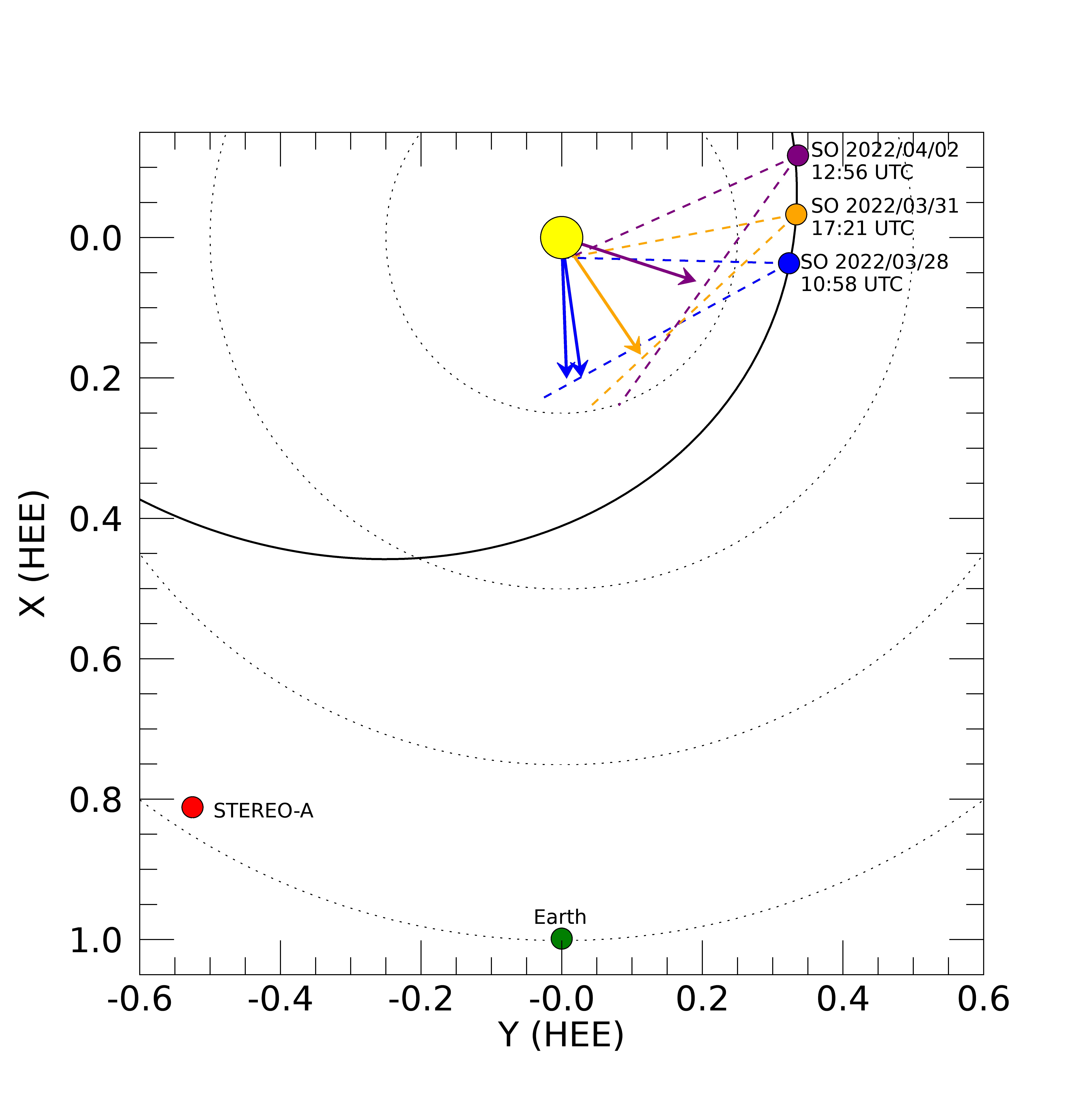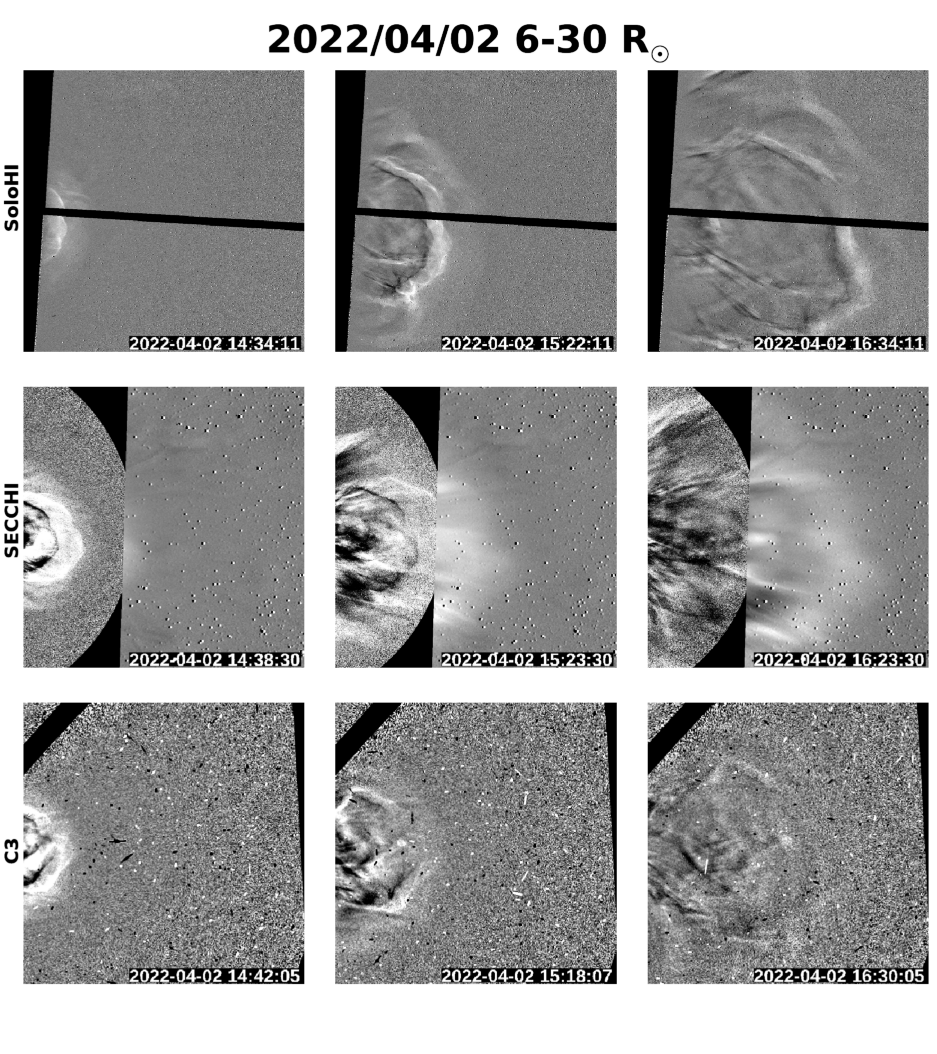Science nugget: High-resolution imaging of coronal mass ejections from SoloHI - Solar Orbiter
High-resolution imaging of coronal mass ejections from soloHI
(Solar Orbiter nugget #9 by Phil Hess1, R.C. Colaninno1, A. Vourlidas2, R.A. Howard2, G. Stenborg2 and the Solo/HI team)
Introduction:
The Solar Orbiter Heliospheric Imager (SoloHI; [1]) on board the Solar Orbiter spacecraft [2] observes the Sun’s corona and heliosphere in white light. SoloHI is a next-generation imager building upon the successful STEREO-SECCHI [3] pathfinder imagers and SOHO-LASCO [4]. Heliospheric imagers are designed to observe the transient solar wind structures originating at the Sun, the most striking being large eruptions of magnetized plasma from the solar corona (i.e., coronal mass ejections or CMEs).
The first-generation heliospheric imagers, all observing from near 1 au, opened up a new research window into the evolution of large-scale structure in the inner heliosphere. Those observations are, however, significantly constrained in resolving fine-scale structures due to the long integration times and cadence. SoloHI, on the other hand, leverages the unique orbital characteristics of Solar Orbiter, to resolve the internal structure of CMEs in much greater detail than previously possible.
Events:
Just after the Solar Orbiter’s first science perihelion in March 2022, SoloHI captured a series of four eruptions (28 March - 2 April), all associated with M or X class flares from NOAA active region 12975. Thanks to the direction of these events and orbital configuration of the operating missions all CMEs were observed clearly by both SoloHI and 1 au imagers (Figure 1).
Since the CMEs propagate between STEREO/SOHO and Solar Orbiter, we can directly compare the observations taken from the SECCHI heliospheric imagers and SoloHI. First we have to identify the region of space that is common among the various imagers. As the telescopes have different FOV and heliocentric distances, translating the angular coverage into heliocentric heights requires the basic assumption that elongation is proportional to the ratio of height divided by the observer distance. SoloHI covered roughly 6 − 50R⊙ during that period. This range spans the outer portion of the COR2 coronagraph (∼ 4 − 15R⊙) and the inner portion of the HI-1 heliospheric imager (∼ 14 − 88R⊙). Comparisons with the LASCO C3 coronagraph are further restricted, as its FOV is approximately (4 − 30R⊙).

Figure 1: The location of Solar Orbiter in HEE coordinates is shown at the onset of the various events alongside the approximate SoloHI FOV (depicted with the dashed lines) at each time. The arrows indicate the approximate CME longitude. The Earth (where SOHO is located) and STEREO-A are also shown. The Earth is fixed in this coordinate system, and STEREO does not move significantly in the 6 day span of these events.
An example of the comparison for the 02 April 2022 CME between SoloHI, SECCHI and LASCO-C3 is shown in Figure 2. Both the CME front and the associated wave are resolved very well in SoloHI, as well as individual finer features behind the CME front. The SECCHI and C3 images, on the other hand, suffer from significant blur, especially in the C3 case. The CME intensity greatly reduces as it reaches the outer field of view. The accompanying movie files also show the other events seen during this period and a comparison between the observations further highlights the improved resolution of SoloHI, though with some noticeable jumps in time due to data gaps caused by spacecraft pointing changes. It is during these gaps that the more synoptic 1 au imaging can provide key missing information.

Figure 2: Roughly co-temporal images of the 02 April CME from SoloHI and the SECCHI in- strument suite, as well as LASCO. To highlight the common FOV, images from all SoloHI tiles, COR2/HI-1 and C3, have been projected onto identical grids, covering 6 to 30 R⊙ in the radial direction and -12 to 12 R⊙ in the y-direction. The SoloHI images have been flipped from their standard viewing direction to ease in the comparison.
Conclusions:
The SoloHI instrument is able to provide incredibly detailed observations of the CME structure, leveraging the inner heliospheric orbit of the Solar Orbiter platform. Systems analysis with the synoptic 1 au imagers enables us to obtain vital information across the multi-scale nature of CMEs — from the large-scale evolution provide by the 1 au observations to the meso-scale structure, uniquely provided by SoloHI. As the mission progresses, SoloHI will continue gathering details on the interior of CMEs in the key coronal heights above 20 R⊙, which have historically been observed with low spatial resolution and cadence. This region corresponds to the transition between the subalfvenic corona to the superalfvenic solar wind and hold importance clues on how coronal structures become part of the heliospheric solar wind.
The detailed analysis of these observations is presented in Hess et al. (2023) (submitted to Astronomy & Astrophysics).
Accompanying movies:
LASCO view:
SECCHI view:
SOLOHI view:
Affiliations:
1 U.S. Naval Research Laboratory, Washington D.C., USA
2 Johns Hopkins University Applied Physics Laboratory, Laurel, MD, USA
Acknowledgments:
Solar Orbiter is a space mission of international collaboration between ESA and NASA, operated by ESA. The Solar Orbiter Heliospheric Imager (SoloHI) instrument was designed, built, and is now operated by the US Naval Research Laboratory with the support of the NASA Heliophysics Division, Solar Orbiter Collaboration Office under DPR NNG09EK11I. The SECCHI data are produced by an international consortium of the NRL, LMSAL, and NASA GSFC (USA), RAL and U. Bham (UK), MPS (Germany), CSL (Belgium), IOTA, and IAS (France). The SOHO/LASCO data used here are produced by a consortium of the Naval Research Laboratory (USA), Max-Planck-Institut fuer Aeronomie (Germany), Laboratoire d’Astronomie (France), and the University of Birmingham (UK). SOHO is a project of international cooperation between ESA and NASA.
References:
[1] Brueckner, G. E., Howard, R. A., Koomen, M. J., et al. 1995, Sol. Phys., 162, 357
[2] Müller, D.; St. Cyr, O. C.; Zouganelis, I.; et al.: 2020, A&A, 642, 1
[3] Howard, R. A., Moses, J. D., Vourlidas, A., et al. 2008, Space Sci. Rev., 136, 67
[4] Howard, R. A., Vourlidas, A., Colaninno, R. C., et al. 2020, A&A, 642, A13
- Removed a total of (1) style margin:0;
Nuggets archive
2025
09/04/2025: Bursty acceleration and 3D trajectories of electrons in a solar flare
02/04/2025: Picoflare jets in the coronal holes and their link to the solar wind
19/03/2025: Radial dependence of solar energetic particle peak fluxes and fluences
12/03/2025: Analysis of solar eruptions deflecting in the low corona
05/03/2025: Propagation of particles inside a magnetic cloud: Solar Orbiter insights
19/02/2025: Rotation motions and signatures of the Alfvén waves in a fan-spine topology
12/02/2025: 'Sun'day everyday: 2 years of Solar Orbiter science nuggets that shed light on some of our star's mysteries
22/01/2025: Velocity field in the solar granulation from two-vantage points
15/01/2025: First joint X-ray solar microflare observations with NuSTAR and Solar Orbiter/STIX
2024
18/12/2024: Shocks in tandem : Solar Orbiter observes a fully formed forward-reverse shock pair in the inner heliosphere
11/12/2024: High-energy insights from an escaping coronal mass ejection
04/12/2024: Investigation of Venus plasma tail using the Solar Orbiter, Parker Solar Probe and Bepi Colombo flybys
27/11/2024: Testing the Flux Expansion Factor – Solar Wind Speed Relation with Solar Orbiter data
20/11/2024:The role of small scale EUV brightenings in the quiet Sun coronal heating
13/11/2024: Improved Insights from the Suprathermal Ion Spectrograph on Solar Orbiter
30/10/2024: Temporally resolved Type III solar radio bursts in the frequency range 3-13 MHz
23/10/2024: Resolving proton and alpha beams for improved understanding of plasma kinetics: SWA-PAS observations
25/09/2024: All microflares that accelerate electrons to high-energies are rooted in sunspots
25/09/2024: Connecting Solar Orbiter and L1 measurements of mesoscale solar wind structures to their coronal source using the Adapt-WSA model
18/09/2024: Modelling the global structure of a coronal mass ejection observed by Solar Orbiter and Parker Solar Probe
28/08/2024: Coordinated observations with the Swedish 1m Solar Telescope and Solar Orbiter
21/08/2024: Multi-source connectivity drives heliospheric solar wind variability
14/08/2024: Composition Mosaics from March 2022
19/06/2024: Coordinated Coronal and Heliospheric Observations During the 2024 Total Solar Eclipse
22/05/2024: Real time space weather prediction with Solar Orbiter
15/05/2024: Hard X ray and microwave pulsations: a signature of the flare energy release process
01/02/2024: Relativistic electrons accelerated by an interplanetary shock wave
11/01/2024: Modelling Two Consecutive Energetic Storm Particle Events observed by Solar Orbiter
2023
14/12/2023: Understanding STIX hard X-ray source motions using field extrapolations
16/11/2023: EUI data reveal a "steady" mode of coronal heating
09/11/2023: A new solution to the ambiguity problem
02/11/2023: Solar Orbiter and Parker Solar Probe jointly take a step forward in understanding coronal heating
25/10/2023: Observations of mini coronal dimmings caused by small-scale eruptions in the quiet Sun
18/10/2023: Fleeting small-scale surface magnetic fields build the quiet-Sun corona
27/09/2023: Solar Orbiter reveals non-field-aligned solar wind proton beams and its role in wave growth activities
20/09/2023: Polarisation of decayless kink oscillations of solar coronal loops
23/08/2023: A sharp EUI and SPICE look into the EUV variability and fine-scale structure associated with coronal rain
02/08/2023: Solar Flare Hard Xrays from the anchor points of an eruptive filament
28/06/2023: 3He-rich solar energetic particle events observed close to the Sun on Solar Orbiter
14/06/2023: Observational Evidence of S-web Source of Slow Solar Wind
31/05/2023: An interesting interplanetary shock
24/05/2023: High-resolution imaging of coronal mass ejections from SoloHI
17/05/2023: Direct assessment of far-side helioseismology using SO/PHI magnetograms
10/05/2023: Measuring the nascent solar wind outflow velocities via the doppler dimming technique
26/04/2023: Imaging and spectroscopic observations of EUV brightenings using SPICE and EUI on board Solar Orbiter
19/04/2023: Hot X-ray onset observations in solar flares with Solar Orbiter/STIX
12/04/2023: Multi-scale structure and composition of ICME prominence material from the Solar Wind Analyser suite
22/03/2023: Langmuir waves associated with magnetic holes in the solar wind
15/03/2023: Radial dependence of the peak intensity of solar energetic electron events in the inner heliosphere
08/03/2023: New insights about EUV brightenings in the quiet sun corona from the Extreme Ultraviolet Imager








































 Sign in
Sign in
 Science & Technology
Science & Technology